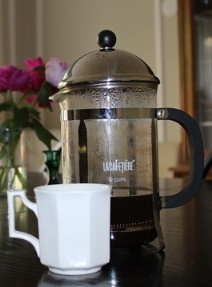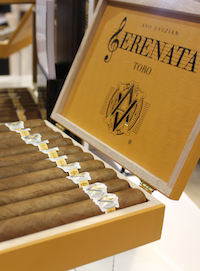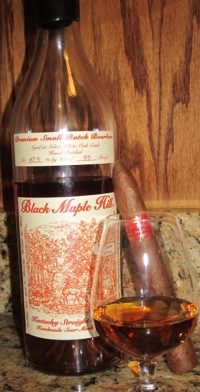Cigar Spirits: Rules of Thumb for Pairing Drinks with Cigars
4 Sep 2013
Over the years my colleagues and I have written many articles about various bourbons, rums, ryes, whiskies, mixed cocktails, beer, and coffee—and which cigars they pair best with. (You can peruse all of those articles here, or you can simply use our search bar at the upper right to locate the libation you’re looking for.) During this time I’ve found a few rules of thumb for pairing drinks with cigars. Keep in mind these conclusions are mine and mine alone. They may fly in the face of my colleagues’ opinions, your own experiences, or even conventional wisdom. But they’ve served me well. I list them here with hopes they help with your own experimentation and/or prompt a constructive dialog.
 Coffee
Coffee
I’ve admittedly turned into a bit of a coffee snob and lately have been favoring Chicago-based producers like Metropolis and Inteligensia. Both have myriad blends that accentuate notes of fruit or nuts over the standard bitter flavor that’s dominant in less superior black coffee. These blends pair outstandingly with milder, Connecticut- or Ecuadorian-wrapped smokes. No, you can’t judge a cigar by the color of its wrapper, but, as a general rule of thumb, lighter, golden wrappers make for excellent coffee companions.
Wine
I’m not a fan of pairing cigars with white wine (or even champagne, for that matter). Big, bold reds, however, tend to be a treat with dark, maduro cigars, particularly those that yield chocolate notes. I’ve especially found that cigars with significant Mata Fina tobacco are good candidates for red wine pairings. I’ll leave any musings on specific varietals—pinot noir, zinfandel, merlot, malbec, etc.—to myself for now since that’s a little too specific for this article’s purpose.
Beer
While I’m not going to win any friends with this opinion, I must say that beer, for me, just doesn’t jive well with cigars at all. I’ve pretty much decided that I’m either smoking a cigar or drinking beer, not both. One tends to ruin the other. My hypothesis is this mismatch stems from my affinity for hoppy, bitter beers. When it comes to pairing a drink with cigars, bitter is not something to look for in a spirit.
Bourbon/Rum
Bourbons and rums are the opposite of beer. Pick any bourbon or rum. Pick any cigar. Relax and enjoy. Whether straight, on the rocks, or even in most mixed drinks, these spirits tend to go well with just about any cigar. The only suggestion I’ll make is, for example, if you’re drinking a particularly sweet rum, like Zaya, pair it with a spicy smoke. The objective is all about balance. And, unlike wine, don’t be afraid to select a full-bodied smoke. Bourbon or rum can hold its own on the palate.
So there you have it. Some general rules of thumb on pairing drinks with cigars from one humble man’s perspective. I look forward to hearing what you have to say in the comments.
photo credit: Stogie Guys

 It’s my belief that quality is going up across the board in the cigar industry, and smoking plenty of samples only solidifies this opinoin. Obviously these are generalizations and no doubt there are exceptions, but it seems not only are the cigars being produced now better constructed than they were 5-10 years ago, they are better cigars that lack obvious flavor flaws. The result is good for consumers. Whether you buy discounted samplers online, or just pick up what looks interesting at your local cigar shop, odds are you’re going to end up with decent or good cigars.
It’s my belief that quality is going up across the board in the cigar industry, and smoking plenty of samples only solidifies this opinoin. Obviously these are generalizations and no doubt there are exceptions, but it seems not only are the cigars being produced now better constructed than they were 5-10 years ago, they are better cigars that lack obvious flavor flaws. The result is good for consumers. Whether you buy discounted samplers online, or just pick up what looks interesting at your local cigar shop, odds are you’re going to end up with decent or good cigars.
 1) Joya de Nicaragua announced yesterday that José Blanco, the company’s senior vice president, has stepped down and will be leaving Estelà for “his roots in the Dominican Republic.†While Blanco’s two-year contract with the oldest cigar maker in Nicaragua will not be renewed, he leaves behind his eponymous, critically acclaimed CyB cigar line (formerly Cuenca y Blanco). Some have speculated CyB’s sales never lived up to expectations—notwithstanding virtually unanimous praise from the online cigar community. The terms of Blanco’s departure did not include a non-compete clause, and StogieGuys.com expects (and hopes) he will continue to work in the industry. Blanco formerly worked at La Aurora in the Dominican for 29 years and is well known for his tasting seminars and extensive travel to cigar shops.
1) Joya de Nicaragua announced yesterday that José Blanco, the company’s senior vice president, has stepped down and will be leaving Estelà for “his roots in the Dominican Republic.†While Blanco’s two-year contract with the oldest cigar maker in Nicaragua will not be renewed, he leaves behind his eponymous, critically acclaimed CyB cigar line (formerly Cuenca y Blanco). Some have speculated CyB’s sales never lived up to expectations—notwithstanding virtually unanimous praise from the online cigar community. The terms of Blanco’s departure did not include a non-compete clause, and StogieGuys.com expects (and hopes) he will continue to work in the industry. Blanco formerly worked at La Aurora in the Dominican for 29 years and is well known for his tasting seminars and extensive travel to cigar shops. The name means “The Cedar,†which refers to the ancient Mediterranean cedar trees which dot the mountains of Lebanon, some of which date back nearly 2000 years. “I chose the cedar tree because to me it embodies eternity… I want ‘The Cedar’ to memorialize those who have fallen for the freedom that every American enjoys,†Elboustani says. (Spanish) cedar also happens to be the type of wood most closely associated cigar making and proper cigar storage.
The name means “The Cedar,†which refers to the ancient Mediterranean cedar trees which dot the mountains of Lebanon, some of which date back nearly 2000 years. “I chose the cedar tree because to me it embodies eternity… I want ‘The Cedar’ to memorialize those who have fallen for the freedom that every American enjoys,†Elboustani says. (Spanish) cedar also happens to be the type of wood most closely associated cigar making and proper cigar storage.
 Few expected Sam Leccia to stay away from the cigar industry any longer than he was legally obligated to. Leccia fans will recall he originally tried to jump back in the business in 2011 with a
Few expected Sam Leccia to stay away from the cigar industry any longer than he was legally obligated to. Leccia fans will recall he originally tried to jump back in the business in 2011 with a  By the way, the same is true of cigars. Some cigar makers have own their factory, while other brand owners contract someone else to make it for them. But for both bourbons and cigars there’s a wide range of those who fall in the latter category. Some companies are completely upfront about who makes their cigars (they may be more like co-producers), while others are completely secretive. Fortunately, for cigars, the top-secret undisclosed factory is the rarity.
By the way, the same is true of cigars. Some cigar makers have own their factory, while other brand owners contract someone else to make it for them. But for both bourbons and cigars there’s a wide range of those who fall in the latter category. Some companies are completely upfront about who makes their cigars (they may be more like co-producers), while others are completely secretive. Fortunately, for cigars, the top-secret undisclosed factory is the rarity. Patrick Ashby
Co-Founder & Editor in Chief
Patrick Ashby
Co-Founder & Editor in Chief Patrick Semmens
Co-Founder & Publisher
Patrick Semmens
Co-Founder & Publisher George Edmonson
Tampa Bureau Chief
George Edmonson
Tampa Bureau Chief